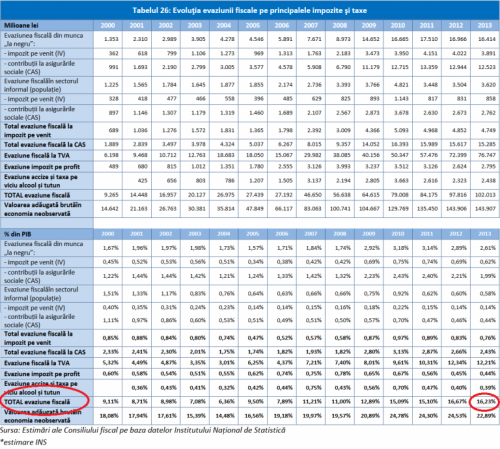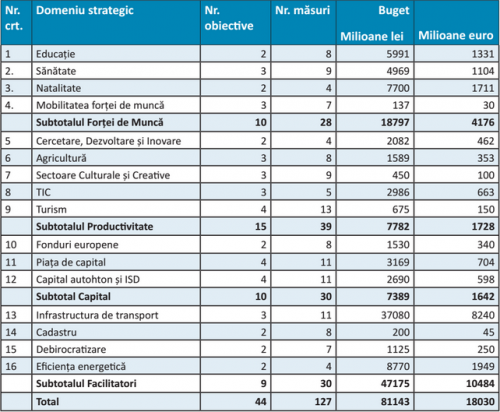 The Ministry of Economy announced on Tuesday the completion of the project for sustainable economic development „Competitive Romania”.
The Ministry of Economy announced on Tuesday the completion of the project for sustainable economic development „Competitive Romania”.
The budget required for full implementation of the strategy „Competitive Romania” is EUR18 billion and represents about 10.7% of GDP for 2016 or about 10% of the average GDP for the period 2016-2020, according to the final document published on the Ministry of Economy’s website.
Although it seems to be an amount difficult to find in the public budgets, it represents less than the annual evasion: According to the Fiscal Council’s estimates, based on the official data of the National Institute of Statistics, tax evasion on the main taxes only represented 16.23% of GDP in 2013 (the last year on which the INS has published clear data on tax evasion).
The final version of the „Competitive Romania” project presents 16 action areas, structured on the three factors contributing to the potential GDP growth and several facilitators. Finally, the 16 strategic areas comprise 44 objectives and 127 measures.
*
Strategic domain No of objectives No of measures Budget (million lei) Million euro
Education
Healthcare
Birth rate
Workforce mobility
Workforce subtotal
Research, development, innovation
Agriculture
Cultural and creative sectors
IT&C
Tourism
Productivity subtotal
EU funds
Capital market
Local capital and FDI
Capital subtotal
Transportation infrastructure
Cadastre
Reducing bureaucracy
Energy efficiency
Facilitators subtotal
Total
*
Estimated budgets for each of the 16 priority action areas. Click to enlarge
The order for presenting the strategic areas included in the „Competitive Romania” project illustrates the logic of the priority for their implementation:
EU FUNDS
is one of the main sources for financing the majority of the public infrastructure projects and removing the causes that block the use of these funds is essential.
The main barriers to accessing structural funds are the inadequacy of central and local administration to the new scheme for accessing the EU funds (lack of administrative capacity able to generate, implement and monitor mature projects, financeable by FESI) and complexity of the project procedures.
Two objectives operationalized by the measures contained in the job sheets, could help remove these barriers by 2020. The first is to strengthen the capacity to develop, monitor and evaluate the public policies in public administration with the aim to develop, implement and monitor a package of mature projects that meets the strategic priorities set by the public policies and in line with the EU guidelines. The second objective aims at simplifying the process and procedures for submitting and implementing the projects financed by FESI.
The estimated budget for the measures envisaged to achieve the two objectives is 1,530 million lei (EUR 340 million) by 2020.
REDUCING BUREAUCRACY
Structural adjustments in the economy needed for sustainable economic growth are dependent on decreasing both the cost that bureaucracy imposes on citizens and the administrative burden on the business environment, which are estimated together at about EUR6,000 million.
Reducing the cost and the administrative burden can be achieved by simplifying the administrative procedures. Two objectives can contribute to this process of simplification. The first one concerns the continuous and rapid de-bureaucratization of all public institutions, while the second aims to reduce total costs on businesses from the administrative fees.
The necessary funds for implementing the measures that can lead to achieving the two objectives amount to 1,125 million lei (EUR 250 million) by 2020.
HEALTHCARE
The sustainable economic growth is a direct result of the quality of human resources, primarily influenced by the population’s state of health.
Increasing employability of the working population becomes possible, on one hand, by pursuing two objectives. The first one aims at decreasing the share of deaths from circulatory diseases to 55 percent of total number of deaths by 2020. The second objective relates to reducing, by 2020, the number of potential years of life lost because of the premature death caused by cerebrovascular diseases.
The funds required to implement the measures needed to achieve these two objectives by 2020 amount to 3,869 billion lei (EUR860 million).
BIRTH RATE
On the other hand, the occupancy rate of population increases in direct relation to the volume of human resources. This is, in turn, the result of, among other things, the birth rate and encouraging migration (whether internal or return migration, or that from third countries).
Birth rate can be encouraged by pursuing three objectives. The first aims at reducing infant mortality rate to 6.5 per thousand by 2020. The second relates to the extension from 1 to 2 years of the maternity leave paid with 85% of the average income in the last 12 months, which might lead to increasing the total fertility rate to 1.8 by 2020.
The third objective aims at increasing the number of full-day kindergartens and encouraging employers to set up kindergartens / nurseries for the employees’ children.
Funds needed to operationalize these three objectives are estimated at 8,800 million lei (EUR1,955 million) by 2020.
WORKFORCE MOBILITY
Encouraging migration is possible through the following three objectives. First, it should be pursued to promote the return migration of Romanians from diaspora. Secondly, programs should be developed to support entrepreneurship in Romania, targeted to Romanians from diaspora. Finally, the flexibility of the process for the admission of citizens from third countries should increase, in order to attract highly qualified personnel.
The budget estimated for implementing the measures needed to operationalize these objectives by 2020 amounts to 137 million lei (EUR30 million).
EDUCATION
Human resource is influenced by population’s level of education. The main objective whose achievement leads to increased contribution of labour to potential GDP is to decrease functional illiteracy, so that 80 percent of students to be above level 2, according to the PISA assessment, in 2020.
The other objective that allows an increased contribution of workforce to potential GDP is to expand by 10 percent the proportion of young people enrolled in dual / professional education, by 2020, and encourage this form of education.
Costs resulting from the measures required to achieve these two objectives by 2020 amounts to approximately 5,991 million lei (EUR1,331 million).
CADASTRE
A quick advance of total productivity of the production factors in Romania, which would be directly and immediately experienced in the advance of potential GDP and economic growth, would be possible by mobilizing the resources from agriculture and facilitating transportation.
Both the increase of productivity in agriculture and construction of highways and railways depends on the quick and correct completion of the public register of real estate in Romania.
Achieving two objectives in the cadastre field would allow significant progress in the above domains. The first refers to decreasing the period required to complete a cadastre contract for a UAT unit, from 76 to 50 weeks. The second envisages the completion of the cadastre for the UAT units located along the route of the highways that represent construction priorities by the end of 2018.
The implementation of the measures needed to achieve the objectives from the cadastre field requires a budget of 200 million lei (EUR45 million) by 2020.
TRANSPORTATION INFRASTRUCTURE
In terms of building the road and railway infrastructure, the main problem that delays the development of the network compared to the regional needs is the gap between the budget needed and the money available. The costs for completing the highway network to strategically connect both the historical provinces between them and Romania to the rest of the European Union amounts to about EUR16 billion, while the EU structural funds allocated for the road infrastructure during 2014-2020 are only EUR4 billion. Besides the need for new construction, approximately 40% of the existing network needs rehabilitation and modernization, which involves additional costs.
To solve this problem three objectives should be followed, two of which are related to the road infrastructure. In terms of building highways, the following need to be done:
(i) the selection of key road infrastructure projects
(ii) improving the institutional framework for implementing the projects
Regarding the railway infrastructure, it needs for the works on the two European corridors (Pan-European Corridor IV and Rhine-Danube Corridor) to be completed. The budget required is EUR 5,200 million, of which EUR 3,100 million have already been allocated and the remaining EUR 2,100 million represent the financing needs.
The budget needed to implement by 2020 the envisaged measures for achieving these objectives amounts to 37,080 million (EUR 8,240 million).
AGRICULTURE
Regarding the agriculture, one of the main obstacles against sector’s contribution to the potential GDP growth is Romanian farmers’ reluctance to join lucrative associations. It is taken into account as main priority to stimulate farmers’ associations in order to facilitate this way their access to the irrigation systems, given that the climate change seriously affects the crops in the southern part of the country.
It is therefore necessary to pursue two objectives that could significantly improve the situation. The first objective is the increase to 12 percent the share of small and medium farmers who are members of lucrative associations, by 2020. The second involves the rehabilitation and modernization of the main irrigation infrastructure, to create by 2020 an additional irrigated area of 250,000 ha and the approval of measures to manage the risks in agriculture caused by climate change.
The estimated cost for implementing the measures needed to achieve the two objectives are estimated at 1,516 million lei (EUR337 million) by 2020.
ENERGETIC EFFICIENCY
The transition to a higher level of potential GDP is hindered by the inefficient use of the energy resources. Romania consumed in 2015 about 1.8 times more primary energy per unit of GDP than the EU average. Boosting energy savings should target the sectors with the highest potential to reduce the final energy consumption.
The increase of the energy efficiency can be achieved by meeting two objectives by 2020. The first one aims at increasing the energy efficiency in the residential sector by reducing annual consumption by about 0.35 million toe. The second one aims at reducing the annual consumption of about 0.1 million toe in the industrial sector.
The budget needed to implement the measures by 2020, to meet the two objectives, is estimated at 8,770 million lei (EUR1,949 million).
LOCAL CAPITAL AND FDI
The development of innovation, research and entrepreneurship can contribute to more efficient use of the production factors. In terms of investment and the ease of doing business, Romania remains the 37th in the world ranking, according to the World Bank Report “Doing Business 2016” published in October 2015, with a total score of 73,78 (with only 0,19 points higher than the previous year).
The creation of a more favourable business environment can be achieved by applying the subsequent actions of the following objectives:
(i) streamlining the state aid procedure and improving the allocation criteria
(ii) encouraging the development of national and regional champions
(iii) the development and operationalization of new funding scheme
(iv) improving relationship between public authorities and investors
The estimated budget for the measures that can contribute to achieving these goals by 2020 is 2,690 million lei (EUR598 million).
CAPITAL MARKET
At present, the capital market is still at an early stage of development in Romania (characterized by low capitalization and liquidity, which places it into the ‘frontier markets’ category) and covers an insignificant part of the financing needs of the local companies. The main reasons for this situation are the low interest of the institutional / international investors, caused by the low liquidity and the limited offer of IPOs / SPOs, and the investors’ reluctance caused by the low transparency of the issuers.
The main objectives that could help place the Bucharest capital market in a higher category in terms of investors’ interest, if met by 2020, are:
(i) sustaining the local capital market towards the development of domestic capital
(ii) developing the private pension system by broadening the investment horizon, to allow funds to participate in the financing and development of infrastructure, real estate and private equity projects
(iii) continuing the program for listings public companies on BSE
(iv) the simplification of the tax registration procedure for foreign investors interested in trading on the Romanian capital market
The budget needed for the measures applicable for achieving these objectives by 2020 is estimated at 3,169 million lei (EUR704 million).
RESEARCH, DEVELOPMENT AND INNOVATION
Attracting the research and innovation in the economic activity is obstructed by a chronic underfunding of the Research, Development and Innovation sector (RDI).
Boosting the research in eco-innovation and clean technologies is essential to produce competitive technologies adapted to the environmental challenges and climate changes which Romania is facing increasingly stronger.
Coordinating the resources to achieve two objectives would allow stimulating the RDI sector.
The first objective is to focus investments on priority infrastructures at the EU level and integrate them into the regional development project „ELI – Laser Valley”. The second aims at creating a stimulating environment for the private initiative by adequate and predictable financing the RDI activities oriented towards smart specialization.
The cost related to these measures needed to achieve the two objectives will reach 2,082 million lei (EUR462 million) by 2020.
INFORMATION TECHNOLOGY AND COMMUNICATIONS
The impact of the technological progress on the Romanian economy should be understood beyond the simple direct contribution of the IT&C sector to the Romania’s GDP, through the influence of the information technology on the whole economy.
The IT&C sector has confirmed its potential to make a real contribution to the local economy, by creating added value four times higher than the national average. Although progress is being made, significant gaps maintain compared to the EU average regarding:
(i) the use of e-government services
(ii) the general use of the Internet and digital literacy
(iii) the increase of confidence of citizens / businesses to use e-commerce
(iv) the integration of the IT&C solutions into domains such as education, healthcare and culture
Materializing the full potential of this sector in terms of economic growth by 2020 depends on achieving the following three objectives:
(i) increase the regular use of the Internet
(ii) increase the coverage of the high-speed broadband infrastructure and cover the „white spots” – 700 localities (Ro-NET project)
(iii) increase the contribution of the IT&C sector to 5% of GDP in 2023.
The implementation of the measures needed to achieve these objectives requires a budget of 2,986 billion lei (EUR663 million) by 2020.
CULTURAL AND CREATIVE SECTORS
The gross added value of the Cultural and Creative Sectors (CCS) had a positive evolution in Romania, with a major increase of their contribution to GDP from 2 percent in 2009 to a significant level of 6.5 percent in 2013. Despite tripling the contribution of these sectors to GDP, the economic potential is largely untapped, at least for the following reasons:
(i) deficient regulatory framework for the intellectual property
(ii) persisting idea that art and creativity do not belong to the „business” area
(iii) lacking entrepreneurial education of the CCS „players”, including in terms of how to capitalize on creativity
(iv) a low demand level, with the notable exception of the IT&C and Advertising
(v) a lack of classic funding (loans) cause by the volatility of the value that creation generates and an information asymmetry between the financial environment and the arts sector.
Targeting three objectives could increase the share of this sector to 10 percent of GDP in 2020. The first objective is related to ensuring the institutional framework needed to support the CSS sector. The second aims at improving and facilitating the access to financing for the CCS sector. Finally, the third is to support the CCS sector through specific programs.
The estimated budget for the measures needed to operationalize these objectives amounts to 450 million lei (EUR 100 million) by 2020.
TOURISM
One of the economic activities that can contribute to potential GDP growth and promote at the same time the conservation of the macroeconomic balance in the foreign relations is tourism. The sector’s contribution to the added value is now below the potential, but also because of statistical techniques. The importance of this activity for the macroeconomic balance should influence the public policy’s interest to achieve a surplus balance of Romania’s revenues from travel and tourism by 2020.
Targeting the following four objectives could allow to partially realize the potential of tourism:
(i) increase the education and training level of the human resources from the hospitality and tourism industry
(ii) increase the quality and performance of the tourism destinations from Romania and ensure the quality standards of the products / services from the tourism industry
(iii) increase Romania’s awareness as quality tourist destination on the international tourism market
(iv) sustainable development of tourism by creating a coherent legislative framework
The cost related to these measures for achieving the four goals will reach 675 million lei (EUR150 million) by 2020.
From where the money comes
According to the annual reports published by the Fiscal Council, based on the INS data, the total tax evasion on the main taxes is higher than the estimated budget for implementing this development project.
 The evolution of tax evasion, source Fiscal Council. Click to enlarge
The evolution of tax evasion, source Fiscal Council. Click to enlarge
The latest annual report of the Fiscal Council does not contain the data about the tax evasion, which have been submitted too late to be checked and added to this document.










